Charles M. Kozierok The TCP-IP Guide
Подождите немного. Документ загружается.

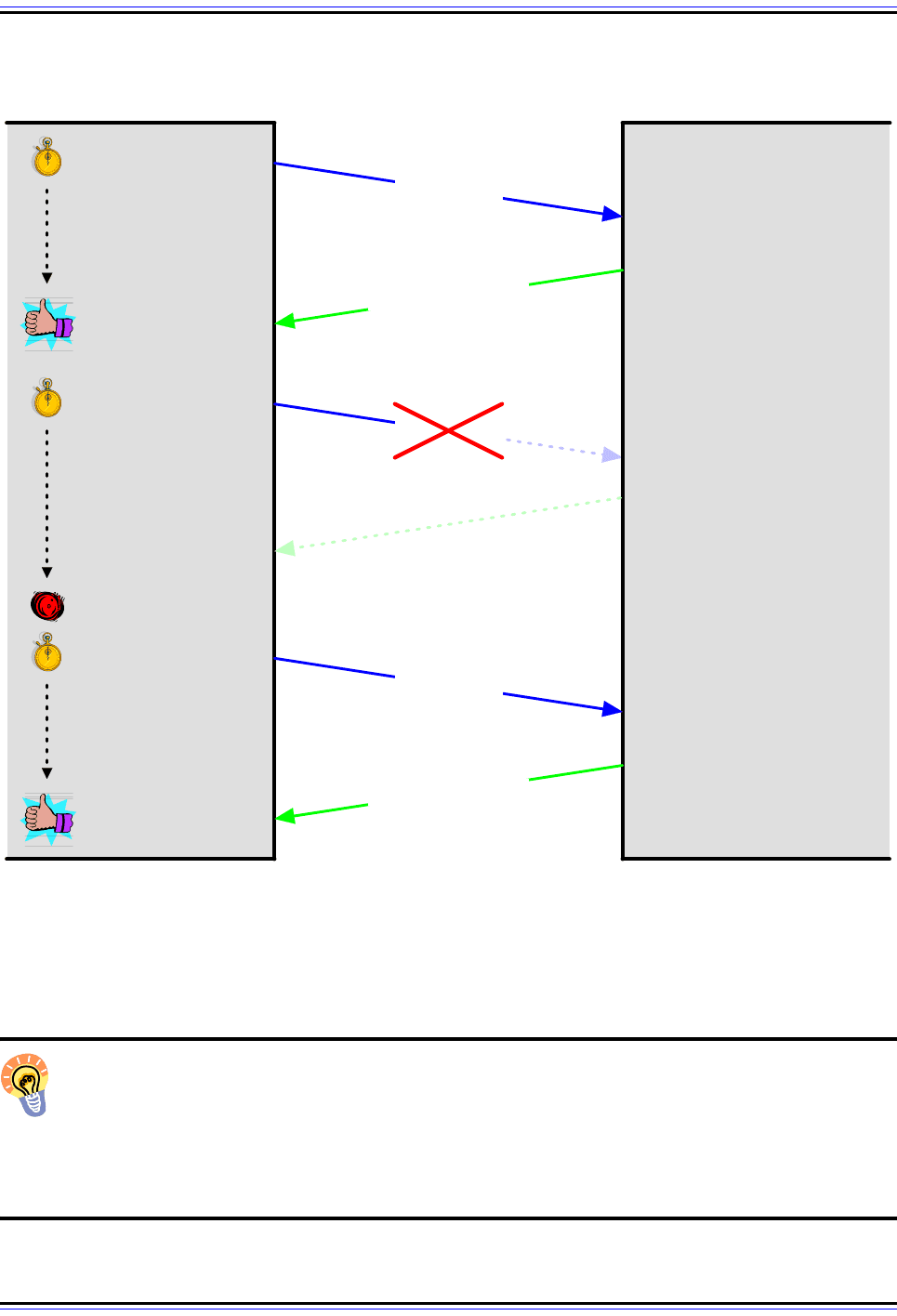
The TCP/IP Guide - Version 3.0 (Contents) ` 851 _ © 2001-2005 Charles M. Kozierok. All Rights Reserved.
Key Concept: A basic technique for ensuring reliability in communications uses a
rule that requires a device to send back an acknowledgment each time it success-
fully receives a transmission. If a transmission is not acknowledged after a period of
time, it is retransmitted by its sender. This system is called positive acknowledgment with
retransmission (PAR). One drawback with this basic scheme is that the transmitter cannot
send a second message until the first has been acknowledged.
Figure 204: Basic Reliability: Positive Acknowledgment With Retransmission (PAR)
This diagram shows one of the most common simple techniques for ensuring reliability. Each time a message
is sent by Device A, it starts a timer. Device B sends an acknowledgment back to A when it receives a
message so A know it was successfully transmitted. If a message is lost, the timer goes off and A retransmits
the data. Note that only one message can be outstanding at any time, making this system rather slow.
Device A Device B
Send Message
and Start Timer
Receive Message
Message
Acknowledgment
Acknowledgment
Received
Send Message
and Start Timer
Message
Message Lost
(Acknowledgment
Not Received)
(Acknowledgment
Not Sent)
Re-Send Message
and Start New Timer
Message
Timer Expiration
Send Acknowledgment
Acknowledgment
Receive Re-Sent
Message
Send Acknowledgment
Acknowledgment
Received

The TCP/IP Guide - Version 3.0 (Contents) ` 852 _ © 2001-2005 Charles M. Kozierok. All Rights Reserved.
Improving the Utility of PAR Through Message Identification and Send Limits
PAR is a technique that is used widely in networking and communications for protocols that
exchange relatively small amounts of data, or exchange data infrequently. The basic
method is functional, but it is not well-suited to a protocol like TCP for two reasons. The first
is that it is inefficient. Device A sends a message and then waits for the acknowledgment.
Device A cannot send another message to Device B until it hears that its original message
was received, which is very wasteful and would make the protocol extremely slow.
The first improvement we can make to this system is to provide some means of identifi-
cation to the messages sent and to the acknowledgments. For example, we could put a
message ID field in the message header. The device sending the message would uniquely
identify it, and the recipient would use this identifier in the acknowledgment. For example,
Device A might send a piece of data in a message with the message ID #1. Device B would
receive the message and then send its own message back to Device A saying “Device A, I
received your message #1”. The advantage of this system is that Device A can send
multiple messages at once. It must keep track of each one sent, and whether or not it was
acknowledged. Each also requires a separate timer, but that's not a big problem.
Of course, we also need to consider this exchange from the standpoint of Device B. Before,
it only had to deal with one message at a time from Device A. Now it may have several
show up all at once. What if it is already busy with transmissions from another device (or
ten)? We need some mechanism that lets Device B say “I am only willing to handle the
following number of messages from you at a time”. We could do that by having the acknowl-
edgment message contain a field, such as send limit, which specifies the maximum number
of unacknowledged messages A was allowed to have in transit to B at one time.
Device A would use this send limit field to restrict the rate at which it sent messages to
Device B. Device B could adjust this field depending on its current load and other factors to
maximize performance in its discussions with Device A. This enhanced system would thus
provide reliability, efficiency and basic data flow control, as illustrated in Figure 205.
Key Concept: The basic PAR reliability scheme can be enhanced by identifying
each message to be sent, so multiple messages can be in transit at once. The use of
a send limit allows the mechanism to also provide flow control capabilities, by
allowing each device to control the rate at which it is sent data.
TCP's Stream-Oriented Sliding Window Acknowledgment System
So, does TCP use this variation on PAR? Of course not! That would be too simple. Well,
actually, the TCP sliding window system is very similar to this method, conceptually, which
is why it is important for us to understand. However, it requires some adjustment. The main
reason has to do with the way TCP handles data: the matter of stream orientation
compared to message orientation discussed in the previous topic. The technique we have
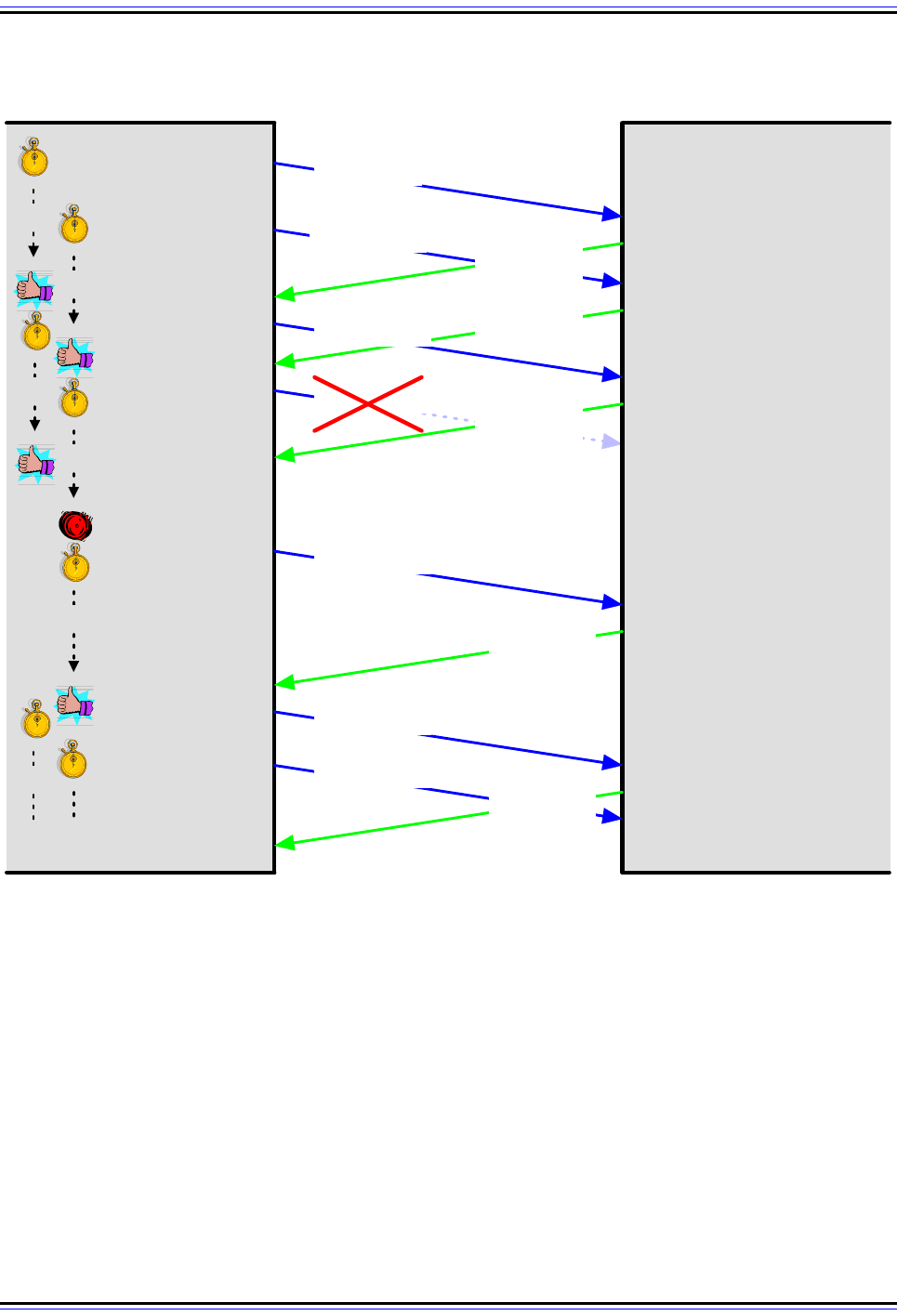
The TCP/IP Guide - Version 3.0 (Contents) ` 853 _ © 2001-2005 Charles M. Kozierok. All Rights Reserved.
outlined involves explicit acknowledgments and (if necessary) retransmissions for
messages. Thus, it would work well for a protocol that exchanged reasonably large
messages on a fairly infrequent basis.
TCP, on the other hand, deals with individual bytes of data as a stream. Transmitting each
byte one at a time and acknowledging each one at a time would quite obviously be absurd.
It would require too much work, and even with overlapped transmissions (not waiting for an
acknowledgment before sending the next piece of data) the result would be horribly slow.
Figure 205: Enhanced Positive Acknowledgment With Retransmission (PAR)
This diagram shows two enhancements to the basic PAR scheme of Figure 204. First, each message now has
an identification number; each can be acknowledged individually, so more than one can be in transit at a given
time. Second, device B regularly communicates to A a send limit parameter, which restricts the number of
messages A can have outstanding at once. B can adjust this parameter to control the flow of data from A.
Device A Device B
Send #1
Receive #1 and
Send Acknowledgment
Ack #1 Received,
Can Now Send #3
#4 Not Received
Timer Expiration,
Re-Send #4
Message #1
Ack #1
Limit = 2
Message #2
Send #2;
Must Stop
(Send Limit is 2)
Ack #2
Limit = 2
Message #3
Ack #2 Received,
Can Now Send #4
Receive #2 and
Send Acknowledgment
Receive #3, Send
Acknowledgment and
Lowe r Se nd Limit
Ack #3
Limit = 1
Message #4
Ack #3 Received,
Cannot Send
(Send Limit Now 1)
Message #4
Receive #4, Send
Acknowledgment and
Raise Limit Back to 2
Ack #4
Limit = 2
Ack #4 Received,
Send #5 and #6
(Send Limit Now 2)
Message #5
Message #6
Receive #5, Send
Acknowledgment
...
...
Ack #5
Limit = 2
#1
#2
#3
#4
#4
#5

The TCP/IP Guide - Version 3.0 (Contents) ` 854 _ © 2001-2005 Charles M. Kozierok. All Rights Reserved.
Of course, this is why TCP doesn't send bytes individually, it divides them into segments. All
of the bytes in a segment are sent together and received together, and thus acknowledged
together. TCP uses a variation on the method we described above, where the identification
of data sent and acknowledged is done using the sequence numbers we discussed in the
previous topic. Instead of acknowledging using something like a message ID field, we
acknowledge data using the sequence number of the last byte of data in the segment.
Thus, we are dealing with a range of bytes in each case, the range representing the
sequence numbers of all the bytes in the segment.
Conceptual Division of the TCP Transmission Stream Into Categories
Imagine a newly-established TCP connection between Device A and Device B. Device A
has a long stream of bytes to be transmitted, but Device B can't accept them all at once. So
it limits Device A to sending a particular number of bytes at once in segments, until the
bytes in the segments already sent have been acknowledged. Then Device A is allowed to
send more bytes. Each device keeps track of which bytes have been sent and which not,
and which have been acknowledged.
At any point in time we can take a “snapshot” of the process. If we do, we can conceptually
divide the bytes that the sending TCP has in its buffer into four categories, viewed as a
timeline (Figure 206):
1. Bytes Sent And Acknowledged: The earliest bytes in the stream will have been sent
and acknowledged. These are basically “accomplished” from the standpoint of the
device sending data. For example, let's suppose that 31 bytes of data have already
been send and acknowledged. These would fall into Category #1.
2. Bytes Sent But Not Yet Acknowledged: These are the bytes that the device has
sent but for which it has not yet received an acknowledgment. The sender cannot
consider these “accomplished” until they are acknowledged. Let's say there are 14
bytes here, in Category #2.
3. Bytes Not Yet Sent For Which Recipient Is Ready: These are bytes that have not
yet been sent, but which the recipient has room for based on its most recent communi-
cation to the sender of how many bytes it is willing to handle at once. The sender will
try to send these immediately (subject to certain algorithmic restrictions we'll explore
later). Suppose there are 6 bytes in Category #3.
4. Bytes Not Yet Sent For Which Recipient Is Not Ready: These are the bytes further
“down the stream” which the sender is not yet allowed to send because the receiver is
not ready. There are 44 bytes in Category #4.
Note: I am using very small numbers here to keep the example simple (and to
make the diagrams a bit easier to construct!) TCP doesn't normally send tiny
numbers of bytes around for efficiency reasons.
The receiving device uses a similar system to differentiate between data received and
acknowledged, not yet received but ready to receive, and not yet received and not yet ready
to receive. In fact, both devices maintain a separate set of variables to keep track of the
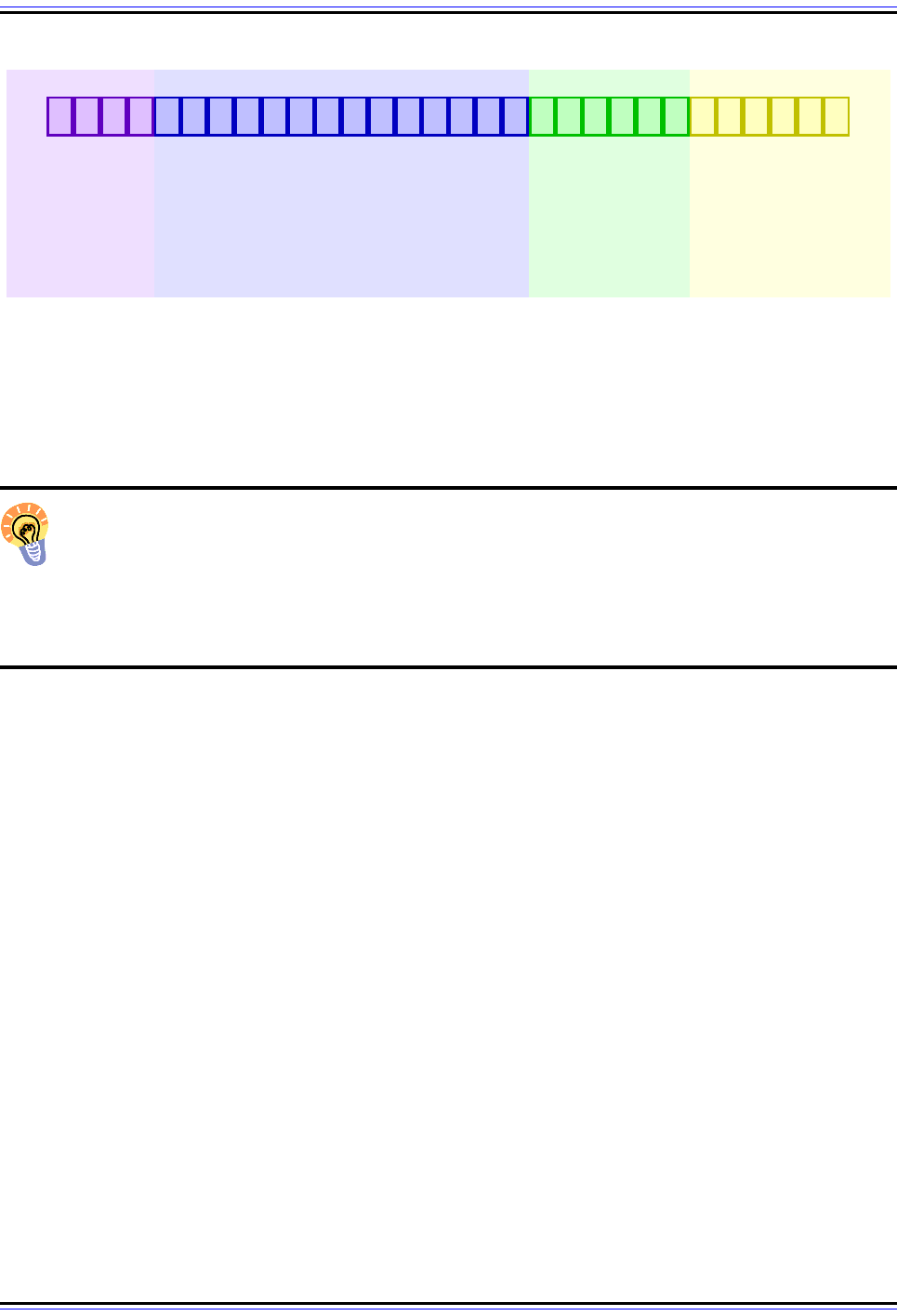
The TCP/IP Guide - Version 3.0 (Contents) ` 855 _ © 2001-2005 Charles M. Kozierok. All Rights Reserved.
categories into which bytes fall in the stream they are sending as well as the one they are
receiving. This is explored in the topic describing the detailed sliding window data transfer
procedure (yes, there’s even more on this subject!)
Key Concept: The TCP sliding window system is a variation on the enhanced PAR
system, with changes made to support TCP’s stream orientation. Each device keeps
track of the status of the byte stream it needs to transmit by dividing them into four
conceptual categories: bytes sent and acknowledged, bytes sent but not yet acknowledged,
bytes not yet sent but that can be sent immediately, and bytes not yet sent that cannot be
sent until the recipient signals that it is ready for them.
Sequence Number Assignment and Synchronization
The sender and receiver must agree on the sequence numbers to assign to the bytes in the
stream. This is called synchronization and is done when the TCP connection is established.
For simplicity, let's assume the first byte was sent with sequence number 1 (this is not
normally the case). Thus, in our example the byte ranges for the four categories are:
1. Bytes Sent And Acknowledged: Bytes 1 to 31.
2. Bytes Sent But Not Yet Acknowledged: Bytes 32 to 45.
3. Bytes Not Yet Sent For Which Recipient Is Ready: Bytes 46 to 51.
4. Bytes Not Yet Sent For Which Recipient Is Not Ready: Bytes 52 to 95.
The Send Window and Usable Window
The key to the operation of the entire process is the number of bytes that the recipient is
allowing the transmitter to have unacknowledged at one time. This is called the send
window, or often, just the window. The window is what determines how many bytes the
sender is allowed to transmit, and is equal to the sum of the number of bytes in Category #2
and Category #3. Thus, the dividing line between the last two categories (bytes not sent
Figure 206: Conceptual Division of TCP Transmission Stream Into Categories
31 32 33 34 35 36 37 38 39 40 41 42 43 44 45 46 47 48 49 50 51 52 53 54 5530
...
29 56 57
...
Category #1 Category #2 Category #3 Category #4
Sent and
Acknowledged
(31 bytes)
Sent But Not Yet Acknowledged
(Sent and Still Outstanding)
28
Not Sent,
Recipient Ready
To Receive
Not Sent, Recipient
Not
Ready To Receive
(44 bytes)
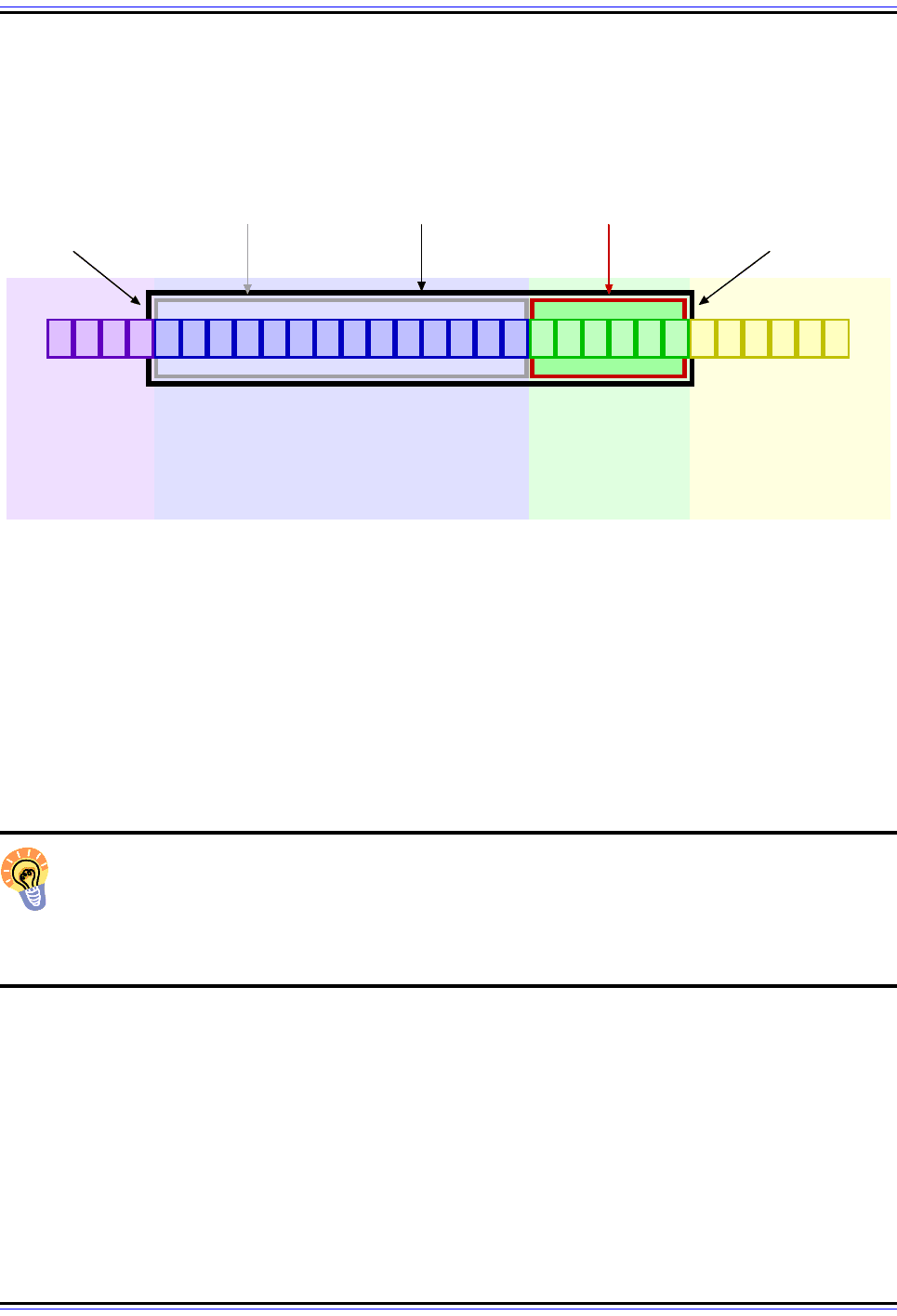
The TCP/IP Guide - Version 3.0 (Contents) ` 856 _ © 2001-2005 Charles M. Kozierok. All Rights Reserved.
that recipient is ready for and ones it is not ready for) is determined by adding the window
to the byte number of the first unacknowledged byte in the stream. In our example above,
the first unacknowledged byte is #32. The total window size is 20.
The term usable window is defined as the amount of data the transmitter is still allowed to
send given the amount of data that is outstanding. It is thus exactly equal to the size of
Category #3. You may also commonly hear mention of the edges of the window. The left
edge marks the first byte in the window (byte 32 above). The right edge marks the last byte
in the window (byte 51). Please see Figure 207 for a graphical view of these concepts.
Key Concept: The send window is the key to the entire TCP sliding window system:
it represents the maximum number of unacknowledged bytes a device is allowed to
have outstanding at once. The usable window is the amount of the send window that
the sender is still allowed to send at any point in time; it is equal to the size of the send
window less the number of unacknowledged bytes already transmitted.
Changes to TCP Categories and Window Sizes After Sending Bytes In the Usable Window
Now, let's suppose that in our example above, there is nothing stopping the sender from
immediately transmitting the 6 bytes in the Category #3 (the usable window). When it does
so, the 6 bytes will shift from Category #3 to Category #2. The byte ranges will now be as
follows (Figure 208):
1. Bytes Sent And Acknowledged: Bytes 1 to 31.
2. Bytes Sent But Not Yet Acknowledged: Bytes 32 to 51.
Figure 207: TCP Transmission Stream Categories and Send Window Terminology
This diagram shows the same categories as Figure 206, with the send window indicated as well. The black
box is the overall send window (categories #2 and #3 combined); the gray represents the bytes already sent
(category #2) and the red box is the usable window (category #3).
31 46 47 48 49 50 51 52 53 54 5530
...
29 56 57
...
Category #1 Category #2 Category #3 Category #4
Sent and
Acknowledged
(31 bytes)
28
Not Sent,
Recipient Ready
To Receive
Not Sent, Recipient
Not
Ready To Receive
(44 bytes)
Left Edge of
Send Window
Right Edge of
Send Window
32 33 34 35 36 37 38 39 40 41 42 43 44 45
Send Window
(20 bytes)
Usable Window
(6 bytes)
Sent But Not Yet Acknowledged
(Sent and Still Outstanding)
Window Already
Sent (14 bytes)
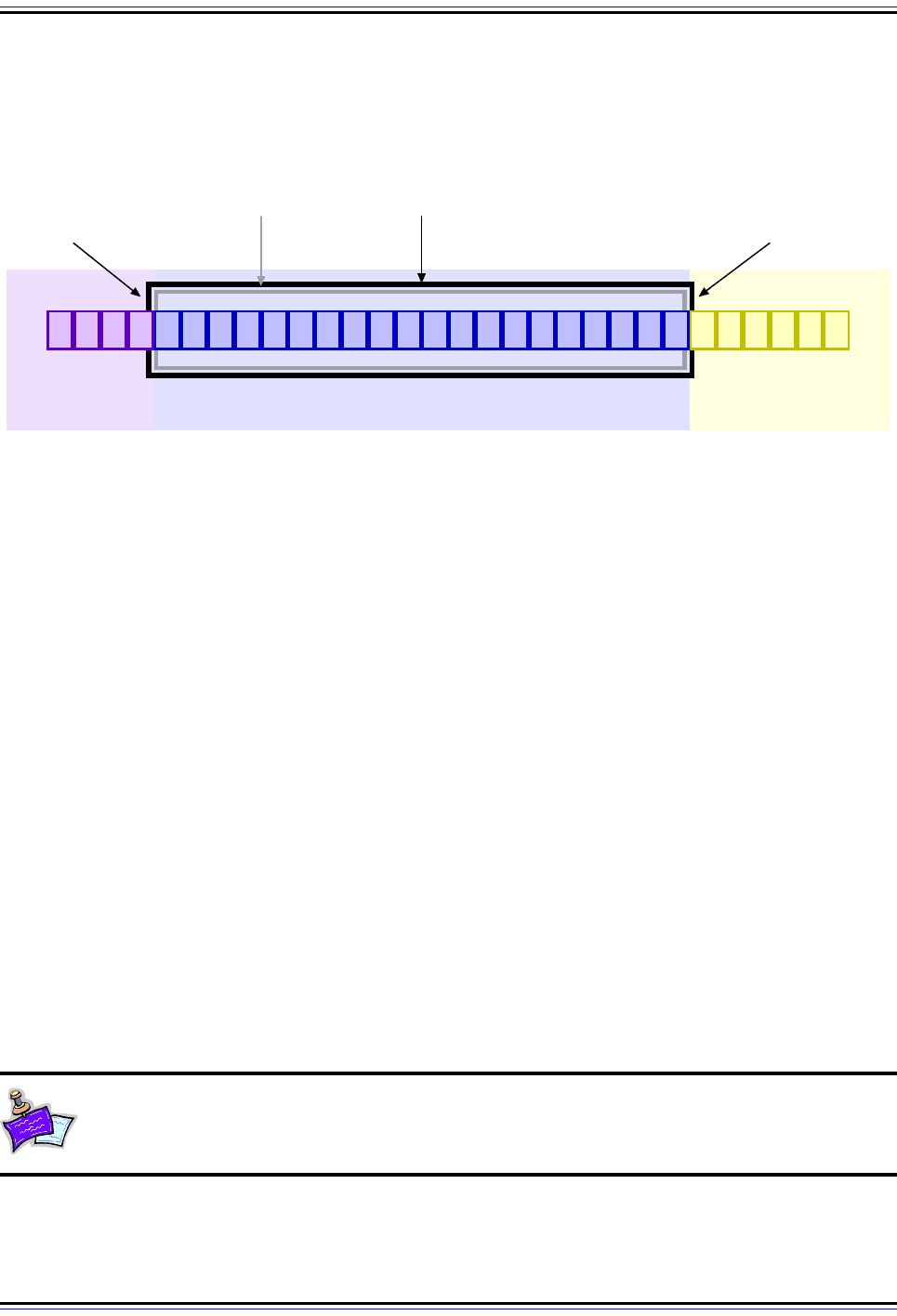
The TCP/IP Guide - Version 3.0 (Contents) ` 857 _ © 2001-2005 Charles M. Kozierok. All Rights Reserved.
3. Bytes Not Yet Sent For Which Recipient Is Ready: None.
4. Bytes Not Yet Sent For Which Recipient Is Not Ready: Bytes 52 to 95.
Processing Acknowledgments and Sliding the Send Window
Some time later, the destination device sends back a message to the sender providing an
acknowledgment. It will not specifically list out the bytes that have been acknowledged,
because as we said before, doing this would be inefficient. Instead, it will acknowledge a
range of bytes that represents the longest contiguous sequence of bytes received since the
ones it had previously acknowledged.
For example, let's suppose that the bytes already sent but not yet acknowledged at the start
of the example (32 to 45) were transmitted in four different segments. These segments
carried bytes 32 to 34, 35 to 36, 37 to 41 and 42 to 45 respectively. The first, second and
fourth segments arrived, but the third did not. The receiver will send back an acknowl-
edgment only for bytes 32 to 36 (32-34 and 35-36). It will hold bytes 42 to 45 but not
acknowledge them, because this would imply receipt of bytes 37 to 41, which have not
shown up yet. This is necessary because TCP is a cumulative acknowledgment system,
which can only use a single number to acknowledge data, the number of the last contiguous
byte in the stream successfully received. Let's also say the destination keeps the window
size the same, at 20 bytes.
Note: An optional feature called selective acknowledgments does allow non-
contiguous blocks of data to be acknowledged. This is explained in a separate
topic in a later section; we'll ignore this complication for now.
Figure 208: TCP Stream Categories and Window After Sending Usable Window Bytes
This diagram shows the result of the device sending all the bytes it is allowed to transmit in its usable window.
It is the same as Figure 207, except that all the bytes in category #3 have moved to category #2. The usable
window is now zero, and will remain so until an acknowledgment is received for bytes in category #2.
31 52 53 54 5530
...
29 56 57
...
Category #1 Category #2 Category #4
28
Left Edge of
Send Window
Right Edge of
Send Window
32 33 34 35 36 37 38 39 40 41 42 43 44 45
Send
Window
(Usable Window
Empty)
(All Of Send Window
Already Used)
46 47 48 49 5150
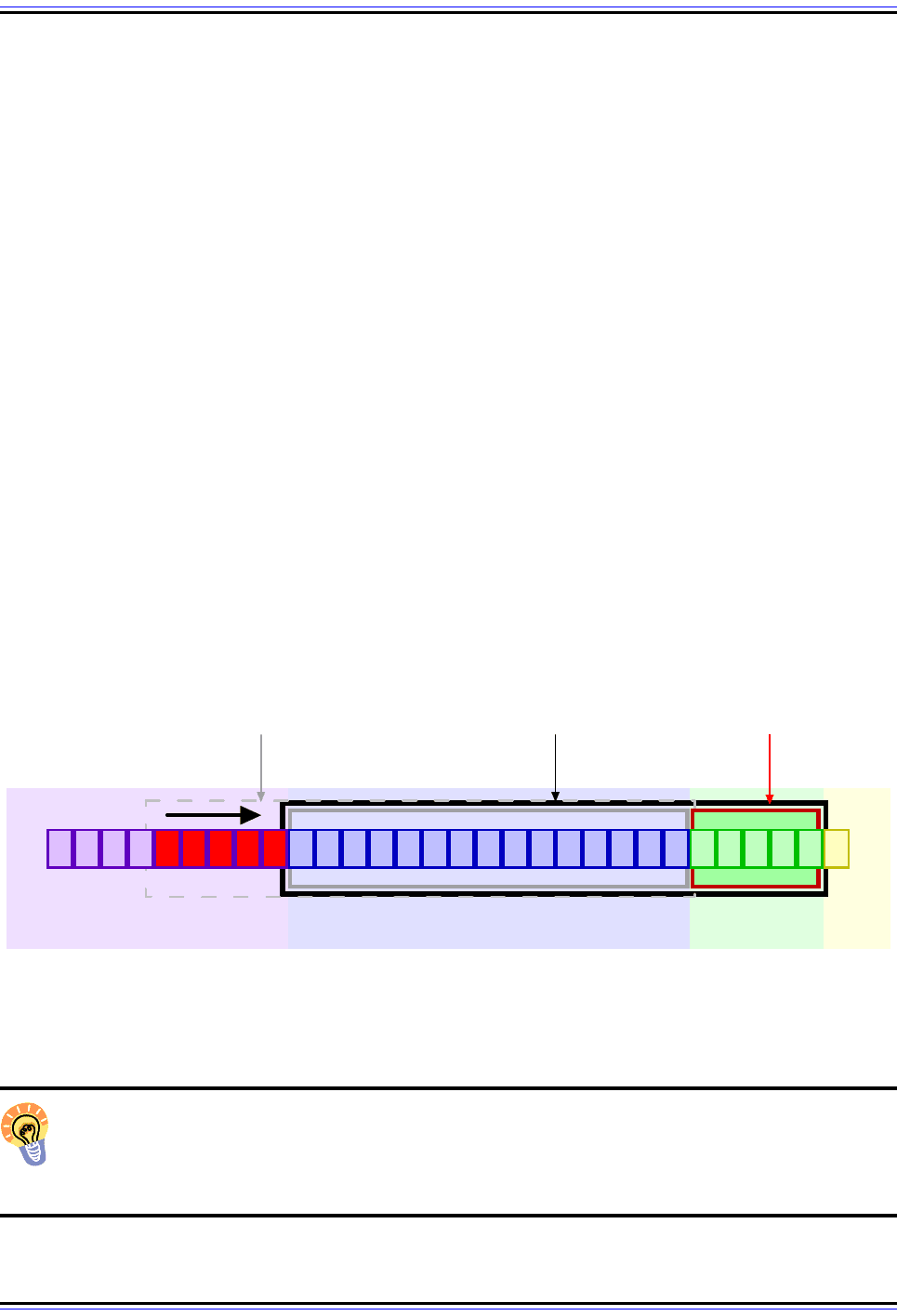
The TCP/IP Guide - Version 3.0 (Contents) ` 858 _ © 2001-2005 Charles M. Kozierok. All Rights Reserved.
When the sending device receives this acknowledgment, it will be able to transfer some of
the bytes from Category #2 to Category #1, since they have now been acknowledged.
When it does so, something interesting will happen. Since five bytes have been acknowl-
edged, and the window size didn't change, the sender is allowed to send five more bytes. In
effect, the window shifts, or slides, over to the right in the timeline. At the same time five
bytes move from Category #2 to Category #1, five bytes move from Category #4 to
Category #3, creating a new usable window for subsequent transmission. So, after receipt
of the acknowledgment, the groups will look like this (Figure 209):
1. Bytes Sent And Acknowledged: Bytes 1 to 36.
2. Bytes Sent But Not Yet Acknowledged: Bytes 37 to 51.
3. Bytes Not Yet Sent For Which Recipient Is Ready: Bytes 52 to 56.
4. Bytes Not Yet Sent For Which Recipient Is Not Ready: Bytes 57 to 95.
This process will occur each time an acknowledgment is received, causing the window to
slide across the entire stream to be transmitted. And thus, ladies and gentlemen, we have
the TCP sliding window acknowledgment system. It is a very powerful technique, which
allows TCP to easily acknowledge an arbitrary number of bytes using a single acknowl-
edgment number, thus providing reliability to the byte-oriented protocol without spending
time on an excessive number of acknowledgments. For simplicity, the example above
leaves the window size constant, but in reality it can be adjusted to allow a recipient to
control the rate at which data is sent, enabling flow control and congestion handling.
Key Concept: When a device gets an acknowledgment for a range of bytes, it
knows they have been successfully received by their destination. It moves them from
the “sent but unacknowledged” to the “sent and acknowledged” category. This
causes the send window to slide to the right, allowing the device to send more data.
Figure 209: Sliding The TCP Send Window
After receiving acknowledgment for bytes 32 to 36, they move from category #2 to #1. The send window of
Figure 208 slides right by five bytes; shifting five bytes from category #4 to #3, opening a new usable window.
30
...
29 57
...
Category #1 Category #2 Cat #4
28 32 33 34 35 36 37 38 39 40 41 42 43 44 45
Send Window
(Slides 5 Bytes To The Right)
46 47 48 49 515031
(Previous Send
Window Position)
New Usable
Window
52 53 54 55 56
Category #3

The TCP/IP Guide - Version 3.0 (Contents) ` 859 _ © 2001-2005 Charles M. Kozierok. All Rights Reserved.
Dealing With Missing Acknowledgments
But wait… what about bytes 42 through 45 in our example? Well, until segment #3
(containing bytes 37 to 41) shows up, the receiving device will not send an acknowl-
edgment for those bytes, nor any others that show up after it. The sender will be able to
send the new bytes added to Category #3: bytes 52 to 56. It will then stop, with the window
“stuck” on bytes 37 to 41.
Of course, like any PAR system, TCP includes a system for timing transmissions and
retransmitting. Eventually, the TCP device will re-send the lost segment, and hopefully this
time it will arrive again. Unfortunately, one drawback of TCP is that since it does not
separately acknowledge segments, this may mean retransmitting other segments that
actually were received by the recipient (such as the segment with bytes 42 to 45). This
starts to get very complex, as discussed in the topic on TCP retransmissions.
Key Concept: TCP acknowledgments are cumulative, and tell a transmitter that all
the bytes up to the sequence number indicated in the acknowledgment were
received successfully. Thus, if bytes are received out of order, they cannot be
acknowledged until all the preceding bytes are received. TCP includes a method for timing
transmissions and retransmitting lost segments if necessary.
More Information on TCP Sliding Windows
I should explicitly point out that despite the length of this topic, the preceding is just a
summary description of the overall operation of sliding windows, and one that does not
include all of the modifications used in modern TCP! As you can see, the sliding window
mechanism is at the heart of the operation of TCP as a whole.
In the section that describes segments and discusses data transfer we will see in more
detail how TCP transmitters decide how and when to create segments for transmission.
The section describing TCP's reliability and data flow control features will provide much
more information on how sliding windows enable a device to manage the flow of data to it
on a TCP connection. It also discusses special problems that can arise if windows size is
not carefully managed, and how problems such as congestion are avoided in TCP imple-
mentations through key changes to the basic sliding window mechanism described in this
topic.
TCP Ports, Connections and Connection Identification
The two TCP/IP transport layer protocols, TCP and UDP, play the same architectural role in
the protocol suite, but do it in very different ways. In fact, one of the few functions that the
two have in common is providing a method of transport-layer addressing and multiplexing.
Through the use of ports, both protocols allow the data from many different application
processes to be aggregated and sent through the IP layer, and then returned up the stack
to the proper application process on the destination device. This is all explained in detail in
the section describing ports and sockets.

The TCP/IP Guide - Version 3.0 (Contents) ` 860 _ © 2001-2005 Charles M. Kozierok. All Rights Reserved.
Despite this commonality, TCP and UDP diverge somewhat even in how they deal with
processes. UDP is a connectionless protocol, which of course means devices do not set up
a formal connection before sending data. UDP doesn't have to use sliding windows, or keep
track of how long it has been since a transmission was sent and so forth. When the UDP
layer on a device receives data it just sends it to the process indicated by the destination
port, and that's that. It can seamlessly handle any number of processes sending it
messages because they are all handled identically.
Connection-Handling Responsibilities
Since TCP is connection-oriented, it has many more responsibilities. Each TCP software
layer needs to be able to support connections to several other TCPs simultaneously. The
operation of each connection is separate from of each other connection, and the TCP
software must manage each independently. It must be sure not only that data is routed to
the right process, but that data transmitted on each connection is managed without any
overlap or confusion.
Connection Identification
The first consequence of this is that each connection must be uniquely identified. This is
done by using the pair of socket identifiers corresponding to the two endpoints of the
connection, where a socket is simply the combination of the IP address and the port
number of each process. This means a socket pair contains four pieces of information:
source address, source port, destination address. Thus, TCP connections are sometimes
said to be described by this addressing quadruple.
I introduced this in the general topic on TCP/IP sockets, where I gave the example of an
HTTP request sent from a client at 177.41.72.6 to a Web site at 41.199.222.3. The server
for that Web site will use well-known port number 80, so its socket is 41.199.222.3:80. If the
client has been assigned ephemeral port number 3,022 for the Web browser, the client
socket is 177.41.72.6:3022. The overall connection between these devices can be
described using this socket pair:
(41.199.222.3:80, 177.41.72.6:3022)
Multiple Connection Management
This identification of connections using both client and server sockets is what provides the
flexibility in allowing multiple connections between devices that we take for granted on the
Internet. For example, busy application server processes (such as Web servers) must be
able to handle connections from more than one client, or the World Wide Web would be
pretty much unusable. Since the connection is identified using the client's socket as well as
the server's, this is no problem. At the same time that the Web server maintains the
connection mentioned just above, it can easily have another connection to say, port 2,199
at IP address 219.31.0.44. This is represented by the connection identifier:
(41.199.222.3:80, 219.31.0.44:2199).
